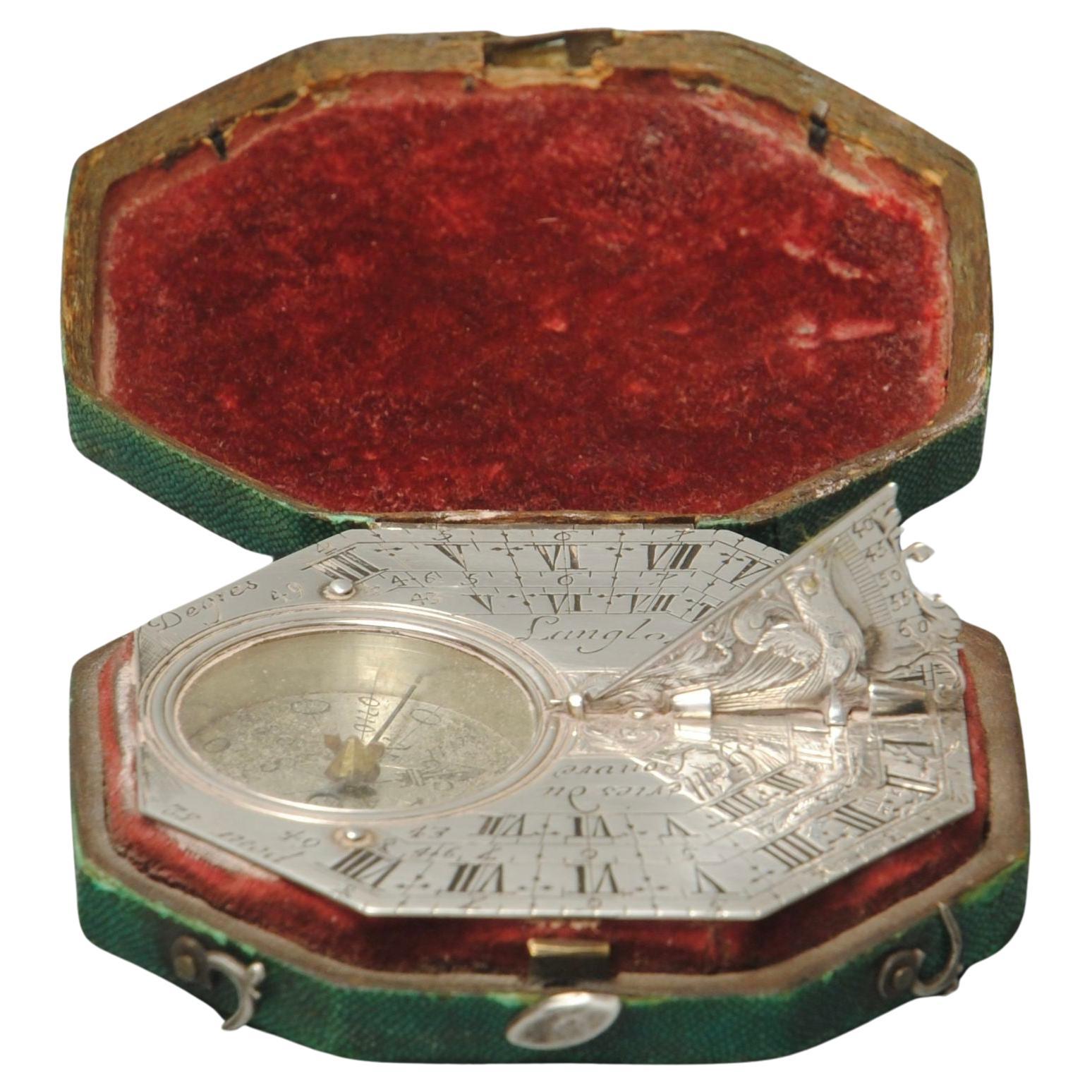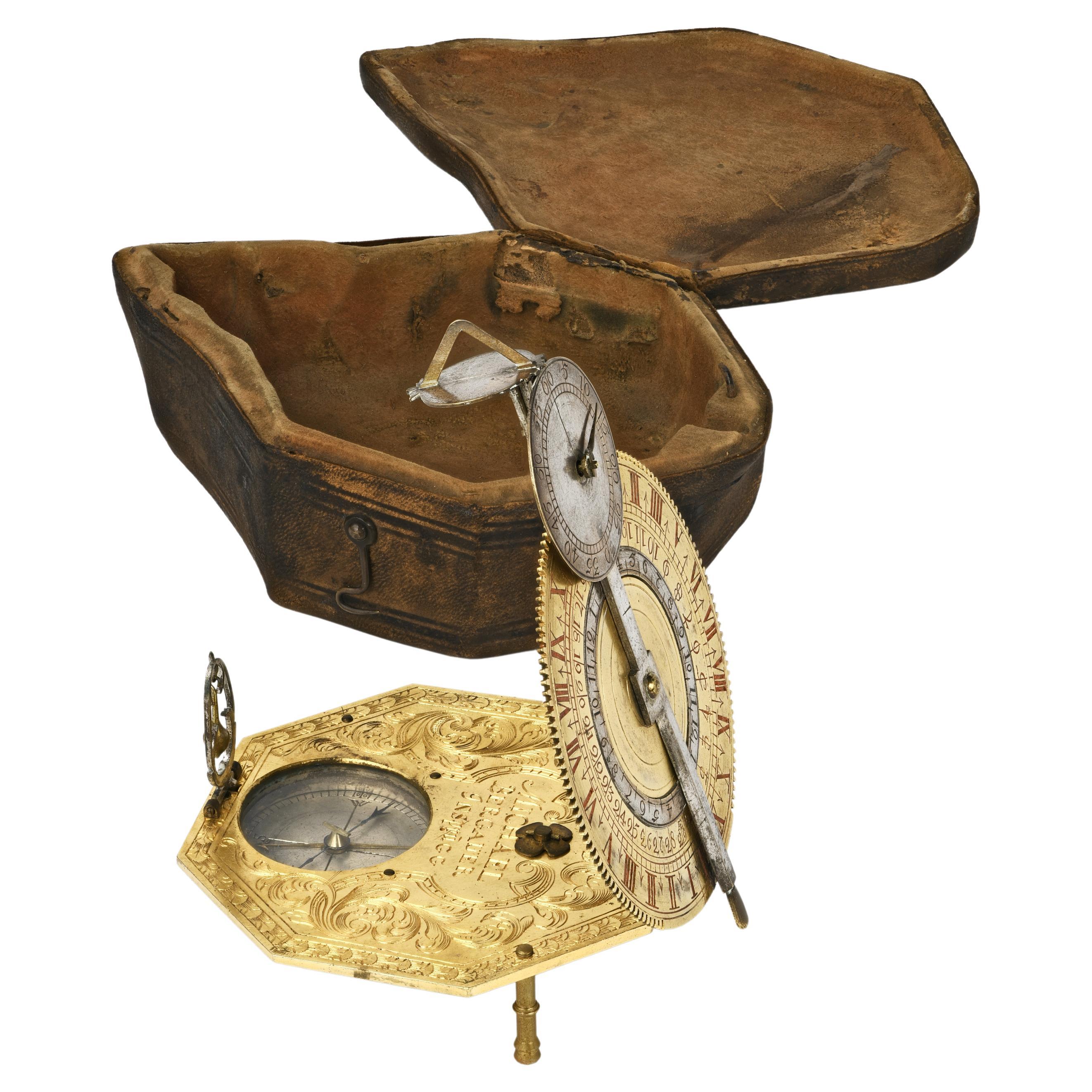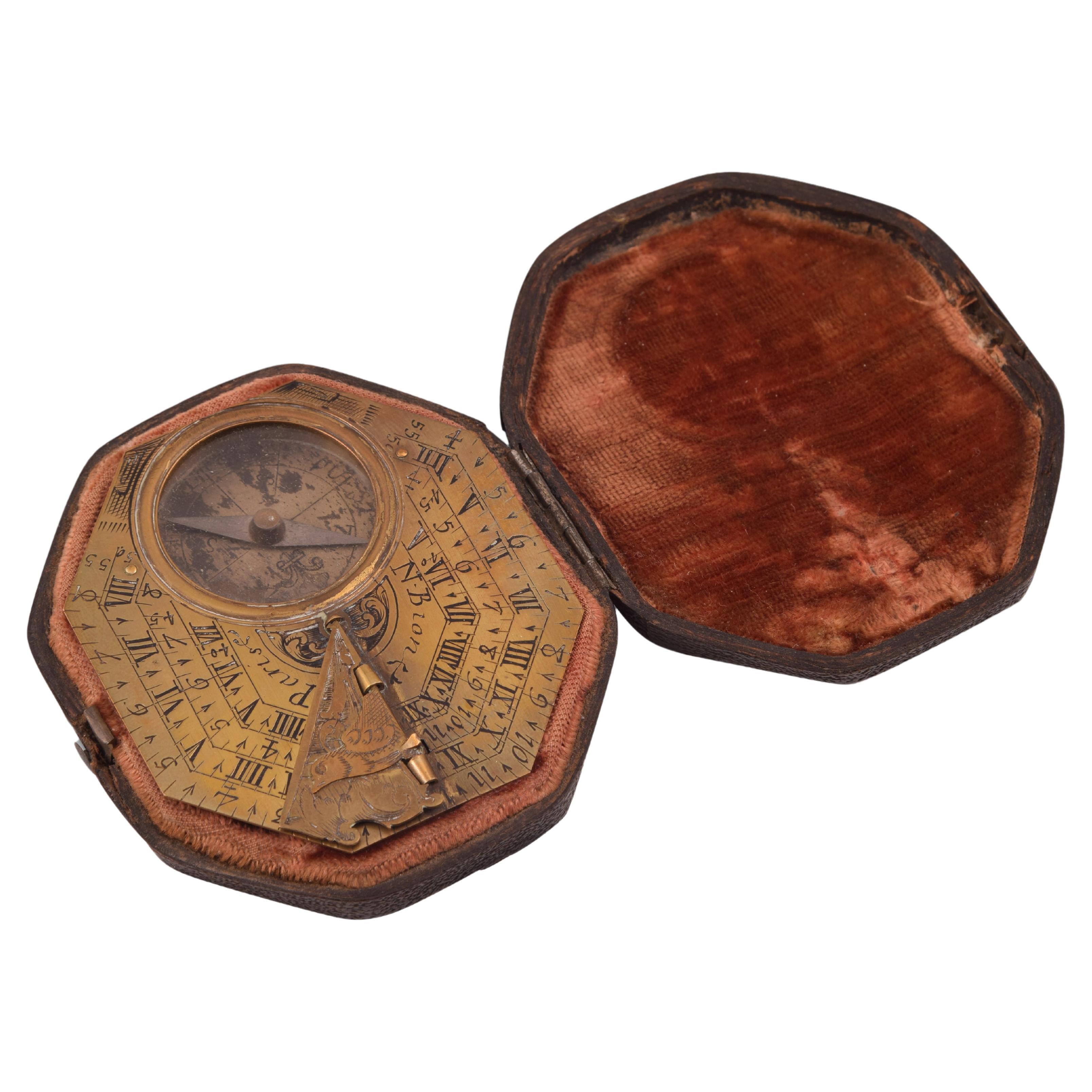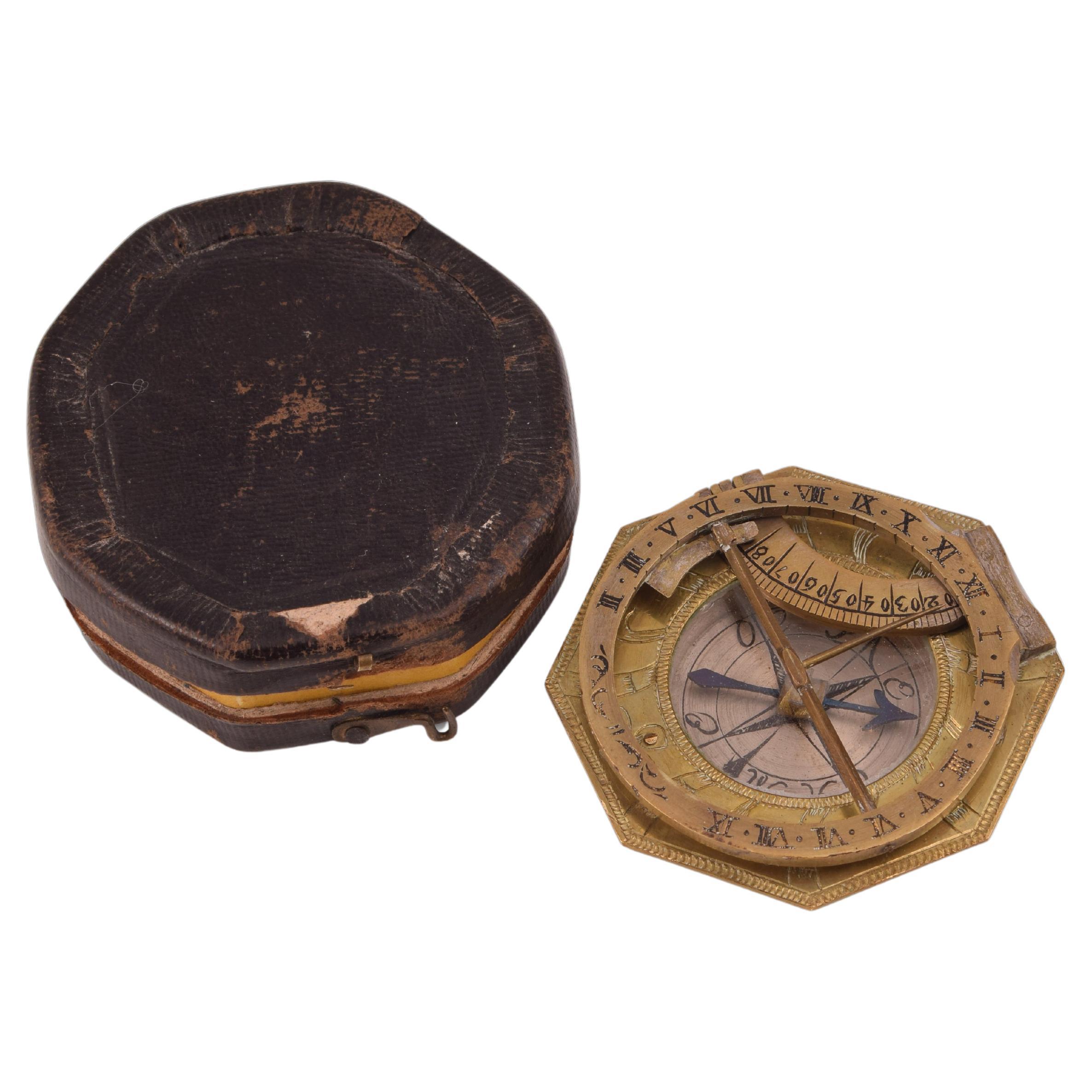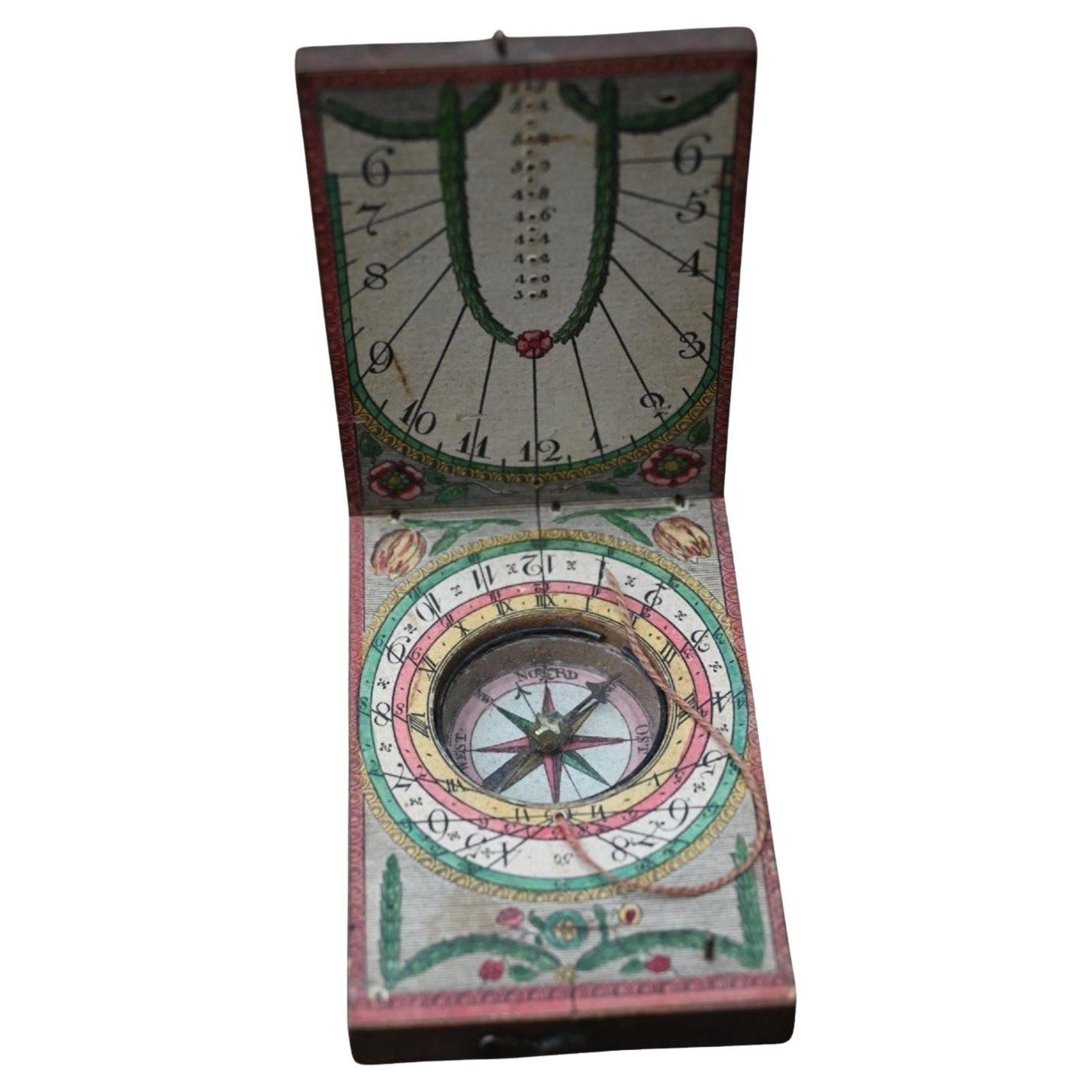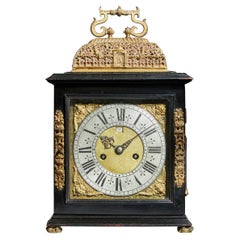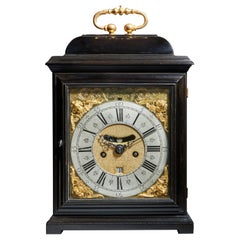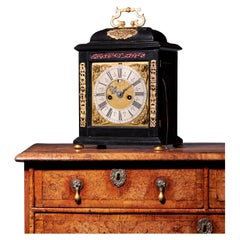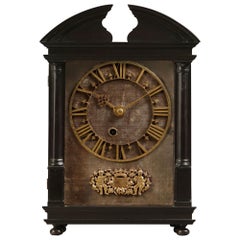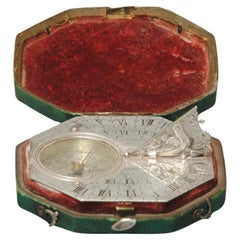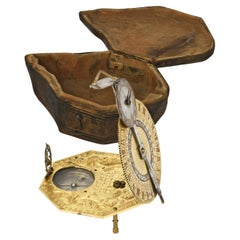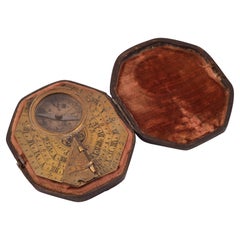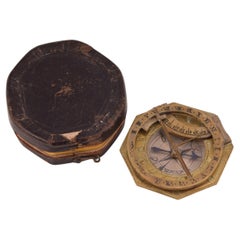Items Similar to Rare Silver Pocket Sundial and Compass by Michael Butterfield, Paris, circa 1700
Want more images or videos?
Request additional images or videos from the seller
1 of 5
Rare Silver Pocket Sundial and Compass by Michael Butterfield, Paris, circa 1700
$6,698.32
£4,900
€5,724.08
CA$9,340.48
A$10,235.83
CHF 5,345.36
MX$123,006.65
NOK 66,826.31
SEK 63,027.86
DKK 42,723.91
About the Item
A beautiful, rare solid silver Anglo-French octagonal pocket sundial with compass by Michael Butterfield, circa 1700.
The sundial is made for a latitude of 44° and could be used in places in the south of France such as Avignon and elsewhere along this parallel. The elaborately engraved base plate has a Roman chapter ring on which the gnomon (a triangular flap) casts its shadow. It is signed by the maker in the following manner: Butterfield A Paris. On one side is a glazed recessed compass with a blued steel hand to position the instrument in such a way that the time can be read. The hinged triangular gnomon is richly engraved and in the shape of a bird’s head. The folding gnomon and cut corners enable the dial to be carried in the pocket.
The underside shows the latitudes of various Southern-French places in the relevant areas
Its maker Michael Butterfield was an English instrument maker who based himself in 'Le Quay de l'Horloge' of Paris from circa 1685. These types of dials, often replicated by other makers, became known as Butterfield Dials after their original inventor.
They were a fashionable and functional traveller’s accessory from the late 17th century onwards. Interestingly, early watches did not keep time particularly well and a dial such as this were used to regularly set a watch. Anecdotally, sundials may also have been preferred to sounding timepieces whilst on the road - the chimes being thought to attract thieves.
Similar examples can be found in the British Maritime Museum, V&A and the British Museum.
Literature:
Tardy, Dictionnaire des horlogers français, Paris, 1971, p. 103
C. Cowham, A Dial in Your Poke, Cambridge, 2004, passim
H.Higton, Sundials, An Illustrated History of Portable Dials, London, 2001, passim.
- Creator:Butterfield Paris (Clockmaker)
- Dimensions:Height: 1.07 in (2.7 cm)Width: 2.29 in (5.8 cm)Depth: 2.56 in (6.5 cm)
- Style:Louis XIV (Of the Period)
- Materials and Techniques:
- Place of Origin:
- Period:Late 17th Century
- Date of Manufacture:1700
- Condition:Wear consistent with age and use.
- Seller Location:Oxfordshire, GB
- Reference Number:1stDibs: LU4936221550362
About the Seller
5.0
Recognized Seller
These prestigious sellers are industry leaders and represent the highest echelon for item quality and design.
1stDibs seller since 2019
24 sales on 1stDibs
Typical response time: A week
Associations
LAPADA - The Association of Arts & Antiques Dealers
- ShippingRetrieving quote...Shipping from: Faringdon , United Kingdom
- Return Policy
Authenticity Guarantee
In the unlikely event there’s an issue with an item’s authenticity, contact us within 1 year for a full refund. DetailsMoney-Back Guarantee
If your item is not as described, is damaged in transit, or does not arrive, contact us within 7 days for a full refund. Details24-Hour Cancellation
You have a 24-hour grace period in which to reconsider your purchase, with no questions asked.Vetted Professional Sellers
Our world-class sellers must adhere to strict standards for service and quality, maintaining the integrity of our listings.Price-Match Guarantee
If you find that a seller listed the same item for a lower price elsewhere, we’ll match it.Trusted Global Delivery
Our best-in-class carrier network provides specialized shipping options worldwide, including custom delivery.More From This Seller
View All17th Century English eight-day spring-driven table clock, by John Wrench
Located in Oxfordshire, United Kingdom
A Rare Late 17th Century English Basket-Top Spring Clock by John Wrench of Chester, Circa 1695-1700. England
This exquisite late 17th-century English basket-top table clock, signed ...
Category
Antique 17th Century English William and Mary Table Clocks and Desk Clocks
Materials
Brass
A rare 17th century English eight-day spring-driven table clock by J Gerrard
Located in Oxfordshire, United Kingdom
A Rare Late 17th Century English Eight-Day Spring-Driven Table Clock, Circa 1700. England
Signed J. Gerrard.
This exceptional late 17th-century English eight-day table clock is a s...
Category
Antique 17th Century English William and Mary Table Clocks and Desk Clocks
Materials
Brass
A 17th Century William and Mary eight-day table clock by Isaac Lowndes, 1695
Located in Oxfordshire, United Kingdom
A fine William and Mary eight-day spring-driven table clock signed on the backplate, Isaac Lowndes Pallmall Court, c.1695.
The elegantly proportioned ebony-veneered oak domed top c...
Category
Antique 17th Century English William and Mary Table Clocks and Desk Clocks
Materials
Brass
17th Century Hague Clock Signed by Pieter Visbagh, circa 1675
By A. Petersen & Co.
Located in Oxfordshire, United Kingdom
Unusually small Hague clock made c. 1675 by Pieter Visbagh, who was apprenticed by Salomon Coster. The latter made the first pendulum clock according to th...
Category
Antique 17th Century Dutch Baroque Wall Clocks
Materials
Ebony, Olive
Rare 18th Century George II Musical Table Clock by Matthew King, circa 1735
Located in Oxfordshire, United Kingdom
A rare George II musical table clock by Matthew King, circa 1735.
This unusual eight-day spring-driven table clock was made by Matthew King, wh...
Category
Antique 18th Century English George II Table Clocks and Desk Clocks
Materials
Silver, Brass
A Rare and Important Charles II 17th Century Table Clock by Henry Jones
By Henry Jones
Located in Oxfordshire, United Kingdom
The Rare and Important 17th Century Spring Driven Table Clock by the Celebrated Maker, Henry Jones.
Provenance dating back to 1745. Owned by Captain Alexander Raitt
A very rare an...
Category
Antique 17th Century English Charles II Table Clocks and Desk Clocks
Materials
Brass
You May Also Like
18th Century Silver Butterfield Dial By Langlois Paris
By Pierre Langlois
Located in Lincolnshire, GB
A fine example of a silver Butterfield type sundial in the original green shagreen case. The finely engraved dial has Premier cadran (first dial) engraved with the city names and lat...
Category
Antique Mid-18th Century French Scientific Instruments
Materials
Silver
Mechanical Equatorial Sundial, Johann Michael Bergauer, Ante 1745
By Johann Michael Bergauer
Located in Milano, IT
Johann Michael Bergauer (Simonsfeld, 1676 - Innsbruck, 1745 circa)
Mechanical equatorial sundial
Signed: Michael Bergauer Insprugg? Innsbruck?
Ante 1745
Gilded and silvered brass; glass.
Measures: closed 1.29 x 3.50 x 4.92 in (33 x 89 x 125 mm); open 5.19 x 3.50 x 3.81 in (132 x 89 x 97 mm).
Weight: the sundial 0.49 lb (224 g); the case 0, 20 lb (95 g)
Original wooden case covered in brown leather.
State of conservation: very good. It has some signs of use. The spring that allowed for the two parts of the instrument to remain open is missing (absent even in the comparative specimens kept in museums).
The sundial is composed of two overlapping plates hinged together on the north edge.
The base plate is octagonal and is supported by three turned legs. The upper face is gilded and a compass with a magnetic variation index has been inserted. The rest of the surface is occupied by a rich decoration of engraved scrolls, centered around the inscription “Michael Bergauer Insprugg”. A foldable oval support with a plumb-bob is attached with a hinge on the southern edge. On the reverse of the base plate a table of the latitudes of some European cities (expanded with the vertical writing “Meiland 40” on the edge and “Rome” deleted) and of Jerusalem has been engraved. A Cam marked for 0 °-70 ° is applied near the northern edge. This can be adjusted to change the inclination of the upper plate according to the latitude; originally a spring, now lost, made it possible to keep the two plates of the clock open.
The second plate is round, has a toothed edge and measures 3.26 in (83 mm) in diameter: it is slightly smaller than the octagonal base which it rests upon and overlaps when the instrument is closed.
The recto is gilded and there are three concentric graduated circles engraved on it:
- the outermost is the equatorial hour dial, numbered I-XII, I-XII;
- the second-one is that of days 1-30 of the lunar month and has “Aetas lunae” engraved on it;
- the third, silvered, is a subsidiary hour dial, with double numbering 1-12; originally it could have been rotated.
The engravings of the first two circles are enameled in red.
In the center - on the polar axis - there is an alidade, at the end of which is associated the silvered minute dial. This, in turn, is welded, perpendicularly, to a small disc, also silvered, with a triangular gnomon. The plate, alidade and minute dial are connected to each other by toothed mechanisms.
Below is the procedure for measuring the time:
1) Adjust the Cam under the base of the clock, based on the latitude of your location;
2) Place the watch on a flat surface using the plumb-bob and with the side closest to the compass facing south;
3) Keeping the instrument still, manually rotate the alidade until the shadow cast by the triangular gnomon on the small silvered disc falls on the line marked below it;
4) The hour and minutes can therefore be read on the hour and minute dials set on the alidade respectively.
Johann Michael Bergauer, who sometimes only signs his works as Michael Bergauer, was born in Simonsfeld, north of Vienna. His apprenticeship as a watchmaker took place in Landshut and he probably worked as a laborer in Augsburg before becoming a watchmaker at the court of Karl Philipp von der Pfalz in Innsbruck in 1708. In the following years, his repeated attempts to obtain Innsbruck citizenship are documented and, in 1721, he is listed as a resident. In 1724 he was admitted to the guild of watchmakers, with which however he had continuous problems. In 1732 he presented a "masterpiece". This is the last reference to his business; he must have died before or in 1745 because in that year his widow appealed to the City Council.
The mechanical sundial...
Category
Antique 1730s Austrian Baroque Scientific Instruments
Materials
Brass
Sundial with Compass and Case, Bronze, Bion, Nicholas, Paris, 18th Century
By Nicholas Bion
Located in Madrid, ES
Sundial with compass and case. Bronze. BION, Nicholas. Paris, 18th century.
Polygonal sundial with a bird-shaped gnomon and engraved triangular piece, which presents, on one side, ...
Category
Antique 18th Century French Neoclassical Scientific Instruments
Materials
Bronze, Other
Sundial and Compass with Case, Schrettegger, Johan, Augsburg, Germany, Ca 1800
Located in Madrid, ES
Sundial and compass with case. Bronze. SCHRETTEGGER, Johan. Augsburg, Germany, around 1800.
Sundial with a polygonal shape made of bronze, engraved with plant elements on the front,...
Category
Antique Late 18th Century German Neoclassical Scientific Instruments
Materials
Bronze, Other
Compass with Pocket Sundial, with Case, Bronze, Butterfield, Michael '1635-1724'
Located in Madrid, ES
Compass with pocket sundial, with case. Bronze. BUTTERFIELD, Michael (1635-1724). Paris, circa 1700.
Pocket sundial made of engraved metal, with a gno...
Category
Antique Early 18th Century French Neoclassical Scientific Instruments
Materials
Metal, Bronze, Other
Antique 18th Century Diptych Portable Sundial And Compass by Beringer
By David Beringer
Located in Bilzen, BE
Antique 18th Century Diptych Sundial and Compass a portable wooden sundial with compass, of German origin, by David Beringer, Nuremberg, dating back to the 1780 circa, in good age re...
Category
Antique Late 18th Century German Louis XVI Scientific Instruments
Materials
Metal
More Ways To Browse
Used Furniture Paris
Rare Antique Silver
Antique Compasses
French Travel Clocks
Antique French Carriage Clock
Rare French Clocks
Antique Silver Carriage
Silver Travel Clock
Silver Carriage Clock
Antique Pocket Clock
Horloge Antique
17th Antique Clock
Pocket Travel Clock
Compass Sundial
French 17th Century Silver
Rare Compass
Antique Compass Sundial
Pocket Compass
